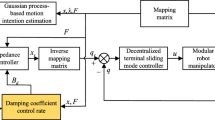Abstract
Compliance is a strong requirement for human–robot interactions. Soft-robots provide an opportunity to cover the lack of compliance in conventional actuation mechanisms, however, the control of them is very challenging given their intrinsic complex motions. Therefore, soft-robots require new approaches to e.g., modeling, control, dynamics, and planning. One of the control strategies that ensures compliance is the impedance control. During the task execution in the presence of coupling force and position constraints, a dynamic behavior increases the flexibility of the impedance control. This imposes some additional constraints on the stability of the control system. To tackle them, we propose a variable impedance control in configuration space for a modular soft robot manipulator (MSRM) in the presence of model uncertainties and external forces. The external loads are estimated in configuration space using a momentum-based approach in order to reduce the calculation complexity, and the adaptive back-stepping sliding mode (ABSM) controller is designed to guard against uncertainties. Stability analysis is performed using Lyapunov theory which guarantees not only the exponential stability of each state under the designed control law, but also the global stability of the closed-loop system. The system performance is benchmarked against other conventional control methods, such as the sliding mode (SM) and inverse dynamics PD controllers. The results show the effectiveness of the proposed variable impedance control in stabilizing the position error and diminishing the impact of the external load compared to SM and PD controllers.













Similar content being viewed by others
References
Burgner-Kahrs J, Rucker DC, Choset H (2015) Continuum robots for medical applications: a survey. IEEE Trans Rob 31:1261–1280. https://doi.org/10.1109/TRO.2015.2489500
Ehsani-Seresht A, Hashemi-Pour Moosavi S (2020) Dynamic modeling of the cable-driven continuum robots in hybrid position-force actuation mode. J Mech Robot. https://doi.org/10.1115/1.4046252
Ji D, Kang TH, Shim S, Hong J (2020) Analysis of twist deformation in wire-driven continuum surgical robot. Int J Control Autom Syst 18:10–20. https://doi.org/10.1007/s12555-018-0400-7
Liu H, Farvardin A, Grupp R, Murphy RJ, Taylor RH, Iordachita I, Armand M (2015) Shape tracking of a dexterous continuum manipulator utilizing two large deflection shape sensors. IEEE Sens J 15:5494–5503. https://doi.org/10.1109/JSEN.2015.2442266
Siciliano B, Villani L (1999) Robot force control. Springer, US
Raibert MH, Craig JJ (1981) Hybrid position/force control of manipulators. J Dyn Syst Meas Contr 103:126–133. https://doi.org/10.1115/1.3139652
Yip MC, Camarillo DB (2016) Model-less hybrid position/force control: a minimalist approach for continuum manipulators in unknown, constrained environments. IEEE Robot Autom Lett 1:844–851. https://doi.org/10.1109/LRA.2016.2526062
Bajo A, Simaan N (2015) Hybrid motion/force control of multi-backbone continuum robots. Int J Robot Res 35:422–434. https://doi.org/10.1177/0278364915584806
Mahvash M, Dupont PE (2011) Stiffness control of surgical continuum manipulators. IEEE Trans Rob 27:334–345. https://doi.org/10.1109/TRO.2011.2105410
Wei Y, Chen Y, Yang Y, Li Y (2016) A soft robotic spine with tunable stiffness based on integrated ball joint and particle jamming. Mechatronics 33:84–92. https://doi.org/10.1016/j.mechatronics.2015.11.008
Hogan N (1985) impedance control: an approach to manipulation: part i—theory. j Dyn Syst Meas Contr 107:1–7. https://doi.org/10.1115/1.3140702
Hogan N (1985) impedance control: an approach to manipulation: part II—implementation. J Dyn Syst Meas Contr 107:8–16. https://doi.org/10.1115/1.3140713
Hogan N (1985) Impedance control: an approach to manipulation: part III—applications. J Dyn Syst Meas Contr 107:17–24. https://doi.org/10.1115/1.3140701
Khan S, Herrmann G, Grafi M, Pipe T, Melhuish C (2014) Compliance control and human-robot interaction: part 1—survey. Int J Human Robot. https://doi.org/10.1142/S0219843614300013
Ba K, Ma G, Yu B, Jin Z, Huang Z, Zhang J, Kong X (2020) A nonlinear model-based variable impedance parameters control for position-based impedance control system of hydraulic drive unit. Int J Control Autom Syst 18:1806–1817. https://doi.org/10.1007/s12555-019-0151-0
Ficuciello F, Villani L, Siciliano B (2015) Variable impedance control of redundant manipulators for intuitive human-robot physical interaction. IEEE Trans Rob 31:850–863. https://doi.org/10.1109/TRO.2015.2430053
Kronander K, Billard A (2016) Stability considerations for variable impedance control. IEEE Trans Rob 32:1298–1305. https://doi.org/10.1109/TRO.2016.2593492
Dong J, Xu J, Zhou Q, Hu S (2020) Physical human–robot interaction force control method based on adaptive variable impedance. J Franklin Inst 357:7864–7878. https://doi.org/10.1016/j.jfranklin.2020.06.007
Duan J, Gan Y, Chen M, Dai X (2018) Adaptive variable impedance control for dynamic contact force tracking in uncertain environment. Robot Auton Syst 102:54–65. https://doi.org/10.1016/j.robot.2018.01.009
Liang L, Chen Y, Liao L, Sun H, Liu Y (2021) a novel impedance control method of rubber unstacking robot dealing with unpredictable and time-variable adhesion force. Robot Comput-Integr Manuf 67:102038. https://doi.org/10.1016/j.rcim.2020.102038
Toscano L, Falkenhahn V, Hildebrandt A, Braghin F, Sawodny O (2015) Configuration space impedance control for continuum manipulators. In: 2015 6th International conference on automation, robotics and applications (ICARA), pp. 597–602. https://doi.org/10.1109/ICARA.2015.7081215
He G, Fan Y, Su T, Zhao L, Zhao Q (2020) variable impedance control of cable actuated continuum manipulators. Int J Control Autom Syst 18:1839–1852. https://doi.org/10.1007/s12555-019-0449-y
Cheng H, Yin YK, Li Z (2003) Dynamics and control of redundantly actuated parallel manipulators. IEEE/ASME Trans Mechatron 8(4):83–91
Mazare M, Taghizadeh M (2019) Adaptive back-stepping robust control of a 3-[P2 (US)] parallel robot on optimal trajectory. Int Robot AutomJ 5(3):101–110. https://doi.org/10.15406/iratj.2019.05.00181
Ficuciell F, Villan L, Siciliano B (2015) Variable impedance control of redundant manipulators for intuitive human–robot physical interaction. IEEE Trans Rob 31(4):850–863. https://doi.org/10.1109/TRO.2015.2430053
Luca D, Albu-Schaffer A, Haddadin S, Hirzinger G (2006) Collision detection and safe reaction with the DLR-III lightweight robot arm. In: IEEE/RSJ international conference on intelligent robots and systems, Beijing, China. pp. 1623–1630 https://doi.org/10.1109/IROS.2006.282053
Funding
This study was not funded by anyone.
Author information
Authors and Affiliations
Corresponding author
Ethics declarations
Conflict of interest
The authors declare that they have no conflict of interest.
Additional information
Publisher's Note
Springer Nature remains neutral with regard to jurisdictional claims in published maps and institutional affiliations.
Rights and permissions
About this article
Cite this article
Mazare, M., Tolu, S. & Taghizadeh, M. Adaptive variable impedance control for a modular soft robot manipulator in configuration space. Meccanica 57, 1–15 (2022). https://doi.org/10.1007/s11012-021-01436-x
Received:
Accepted:
Published:
Issue Date:
DOI: https://doi.org/10.1007/s11012-021-01436-x




